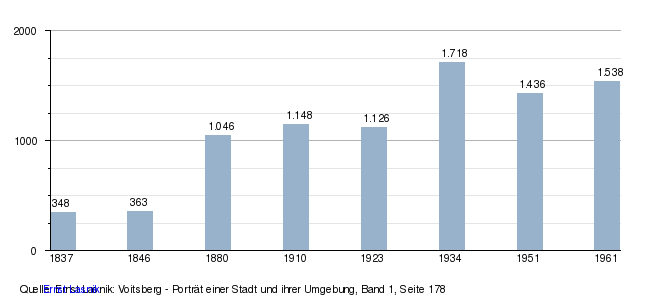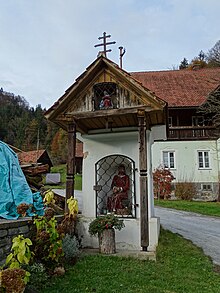Kowald (municipality of Voitsberg)
|
Kowald ( scattered houses ) cadastral community Kowald |
||
|---|---|---|
|
|
||
| Basic data | ||
| Pole. District , state | Voitsberg (VO), Styria | |
| Judicial district | Voitsberg | |
| Pole. local community | Voitsberg | |
| Locality | Voitsberg | |
| Coordinates | 47 ° 2 '19 " N , 15 ° 7' 51" E | |
| height | 490 m above sea level A. | |
| Area d. KG | 5.85 km² | |
| Statistical identification | ||
| Cadastral parish number | 63331 | |
| Counting district / district | Residential-mining-industrial building: Kowald-Nord (61625 012); Rural area: Kowald-Süd (61 625 033) | |
| Municipality 1850–1967 Source: STAT : Directory of places ; BEV : GEONAM ; GIS-Stmk |
||
Kowald is a scattered settlement on the Köflach-Voitsberger basin in Styria and is also a cadastral community of the municipality of Voitsberg in the Voitsberg district . It was an independent political municipality from 1850 to January 1, 1968.
Place name and geography
The name Kowald does not come from the word Kobold , but probably from the name of an area on the Kowalt or a farm or owner's name. The place itself is a high medieval clearing area with individual farms and wastelands .
history
Archaeological finds suggest a settlement during the Roman Empire. The village was first mentioned in 1393 as Chobolt . Further mentions come from the years 1410 as if the Chobolt zu Voytsperg , 1459 as am Kobalt and 1498 as Am Khowolt . Until 1848, subjects of the lords of Altenberg , Greißenegg , Kleinkainach , Krems , Lankowitz , Leonroth , Ligist , Obervoitsberg , Piber , Rehregg and Stadl lived in Kowald , who gave their tithe in the form of grain.
In 1792 the city was commissioned Voitsberg in Kowald by coal reserves dug, which supposedly already in 1767 by the trades were discovered Anton Weidinger. From 1842, Dr. Josef Schweighofer the Katharinen-Schacht put into operation. For the period around 1850, two carp ponds belonging to the Greißenegg estate are documented.
In 1850 it was constituted as a "free local community Kowald". This lasted until it was incorporated into the municipality of Voitsberg on January 1st, 1968.
- Anton Behmer (1868)
- Kajetan Zapfl? (1881/1883)
- Johann Schneebauer (1885)
- Simon Hösel (1886-1889)
- Zenobius Riemer (1890-1919)
- Felix Lesky (1919–1933)
- Josef Gußmack (February 20, 1934) as government commissioner
- N. Gantschnigg (1936)
- Josef Gußmack (1937)
- Felix Lesky (1938–1945)
- Franz Edler (July 1945–1948)
- Franz Gössler (1948–1967)
The mining of iron ore began in 1852 by the Carl Mayr trade in the Barbara tunnel , but had to be stopped again around 1860 due to insufficient deposits. In 1859 Karl Pollay founded the privately owned Voitsberger Actien-Glasfabriksgesellschaft , a glass factory which was sold to S. Reich & Co. in 1876. The brick kiln built in 1868 by Anton and Eleonore Ulrich later became the Kowald brickworks . In 1868 Kowald belonged to the Voitsberg Sanitary Paleon and medical care was provided from Voitsberg. The establishment of a voluntary plant fire brigade in the glass factory is documented for the year 1872 . There is also evidence of a kit forge in Kowald, where tools were made for the period around 1870/80.
In the course of the construction of a water pipe for the city of Voitsberg in 1912, some parts of the municipality of Kowald were also supplied with drinking water. A first planned incorporation to Voitsberg in 1919 failed due to resistance from the Kowald population. The Steirische Bergbaugesellschaft mb H. had new coal deposits digged in 1922. Starting in 1924, the first houses in the community were supplied with electricity from an electricity company in Voitsberg via a transformer station of the Kowald electricity cooperative. In January 1934 there were 105 long-term unemployed in the Kowald community. When Governor Anton Rintelen came to Voitsberg for a visit in the same year, balloons with a swastika flag were raised in Kowald and an explosive device was detonated at the glass house of the Greißenegg castle nursery. On February 12, 1934, the workers of the glass factory went on strike and from February 15, riots broke out as a result of which the Kowald municipal council was dissolved and a government commissioner was appointed. In November 1944 156 prisoners of war who had to work in Kowald were registered. Several buildings were badly damaged and several people were killed in Allied bombing raids.
On April 8, 1946, women from miners and glass workers from Kowald took part in a demonstration against the lack of food supplies in front of the district authority in Voitsberg. On November 8th of the same year all official bodies approved the establishment of the Rudolf Bauer pump factory . The Gößnitz creek flooded and vermurte on 25 July 1948 after heavy storms fields and meadows several farmers of the community, which partly led to severe crop losses. In May 1949 the cultural association of the working people of the Voitsberg glass factory was founded.
On January 1, 1968, Kowald was incorporated into the municipality of Voitsberg.
Population development

Buildings
The most notable buildings in Kowald include the Wolfshuber Chapel, built after the Second World War, and the Moarhof Chapel, which was probably built in the 18th century, with a statue of the martyred Christ. There is also a tabernacle shrine near Greißenegg Castle .
Individual evidence
- ↑ a b c d e f g h i Ernst Lasnik : Voitsberg - portrait of a city and its surroundings . tape 1 . Municipality of Voitsberg, Voitsberg 2012, p. 177-179 .
Web links
- 61625 - Voitsberg. Community data, Statistics Austria .


